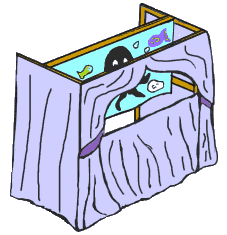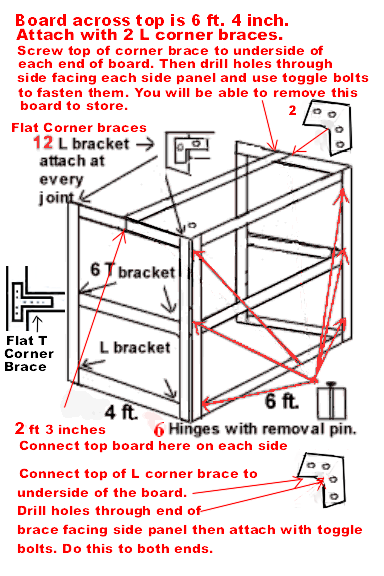|
Hand Puppet Stage Puppet Stage


This hand puppet stage is fairly simple to construct and this design can be modified to meet your needs,
by changing any of the dimensions or changing the materials used to construct it.
The sides may be
three or four feet wide and the front of the stage could be four, five,
or six feet in length
depending upon the size of the stage you desire.
Twelve L shaped brackets (Called Flat Corner brackets) and six T shaped brackets
( T mending braces) may be used to connect the lengths of boards into the three sections you see
here.
The three sections and the top bar or runner are then connected by using
six hinges with removable pins,
and 2 L corner brackets to join them together.
You will need wood screws to screw on the brackets, a hand saw to cut the wood,
a screw driver or a hand drill to make your holes to attach the braces to the stage.
The stage below is for a theater that when completed is 6 foot 6 inches
across the front
and 6 feet high with side panels that are 4 foot 4
inches wide.
Construct the side panels and front panel before attaching hinges!
Hinges will be attached an inch beneath the flat L braces at the top of
these panels
and an inch beneath the T mending braces.
The bottom hinge will be attached an inch above the bottom board in
these panels!
When this is done cut the runner and follow these directions!
A. B. B.
C.

Close Up of Hinge with removable pin. 3 of these
hinges are attached on the left and 3 on right hand sides of the stage and are used to join
sections A. and B. (to the front off the stage),
section C.
[The removal pin makes it possible to take the stage apart for storage or to
move.
Of course you can use cabinet hinges that do not have a removal pin
if it is meant to be a stationary stage.
These hinges may be 2 or 1/2 inches long.
You can use door hinges but if you do,
you need to be very careful attaching them as they are heavier.]
12
L shaped brackets and 6 T shaped brackets are used to construct sections A, B, and
C.
They are placed where each board needs to be attached to another piece in it's section.
The T brackets or braces (called T mending braces) are used to connect the middle pieces of wood in each of the 3 sections. A Stage
6 ft 6" long by 6 ft high
with side panels 4 feet 6 inches wide would require
13 narrow boards of pine (or strapping as it is
sometimes called) 3 wide, by 8 ft long to be cut in the following lengths.
9 boards cut in 6 ft lengths.
3 boards would be cut in 4 ft lengths for the side panels.
**The runner at the top would be
1 piece, 6ft
4inches long 3 inches wide and 1 inch thick.
The runner will need to be measured to fit perfectly.
(Cut this board last in case your theater is a little off
because of slight imperfections in your cutting or
the brackets you attached. You can adjust this to match the length you need to
make it squared.)
A
corner brace or L shaped bracket is then attached underneath each side of this
board flush with the end of it on either end with the other side of the brace attached to the top board of sections A and B.
It is best to connect your corner brace or L bracket to the underside of the
runner at each end with permanent screws. Then you will drill out holes on L
Corner brace abutting, (meeting) the A and B panels
in order to put toggle bolts through them that will secure the runner to the
sides.
The width of the bolts depends on the braces you purchase.
They need to be big enough to keep from sliding totally though the hole.
This provides the support for the sides of your stage, as well as, providing the brace needed
to attach either scenery for your shows or a back curtain to hide you, the puppeteer from your audience.
The toggle bolts make it possible to remove the runner for storage.
The frame is then covered over with cloth
as you see in the first figure on this page.
A curtain rod, which is optional, may also be attached to the top board
running the length of the front of the stage for opening and closing your curtain.
You may need from 8 to 12 yards of material depending on the size of the stage.
[Or you may decide to attach panels along the sides and in the front, made out of mason board or formica.
These may be glued on, or nailed on, but you must use nails short enough not to crack your pine frame boards.
You will have to drill holes for L brackets for runner as well if this is to be
a stage you want to take apart.]
A curtain may still be attached to the top front of the stage for opening and closing or
left open for a finished theatrical look.
**Please take
note, of this direction. Read before cutting the runner.

|
![]() Fly
Home
Fly
Home ![]() Backstage
Backstage ![]() Meet Me
Meet Me
![]() Egg
Site
Egg
Site
![]() Activities
Activities
![]() Puzzles
Puzzles